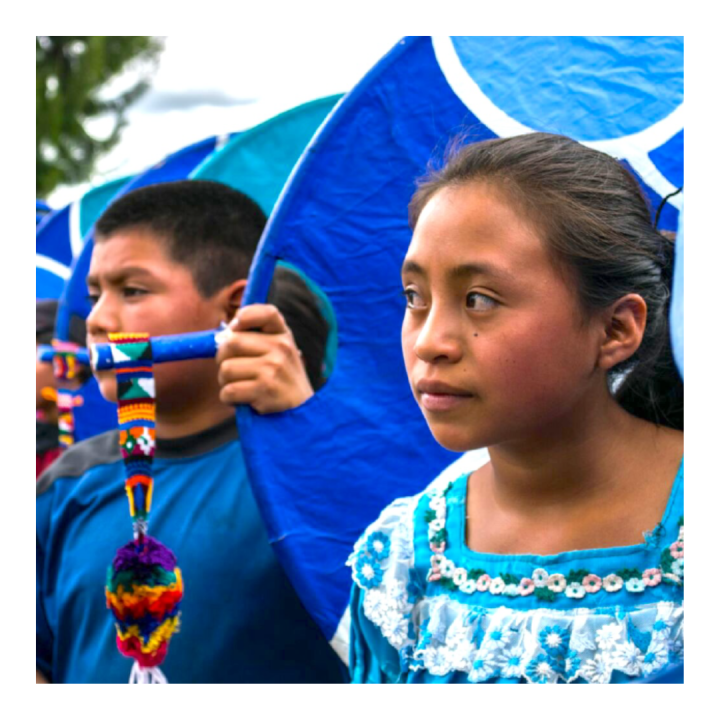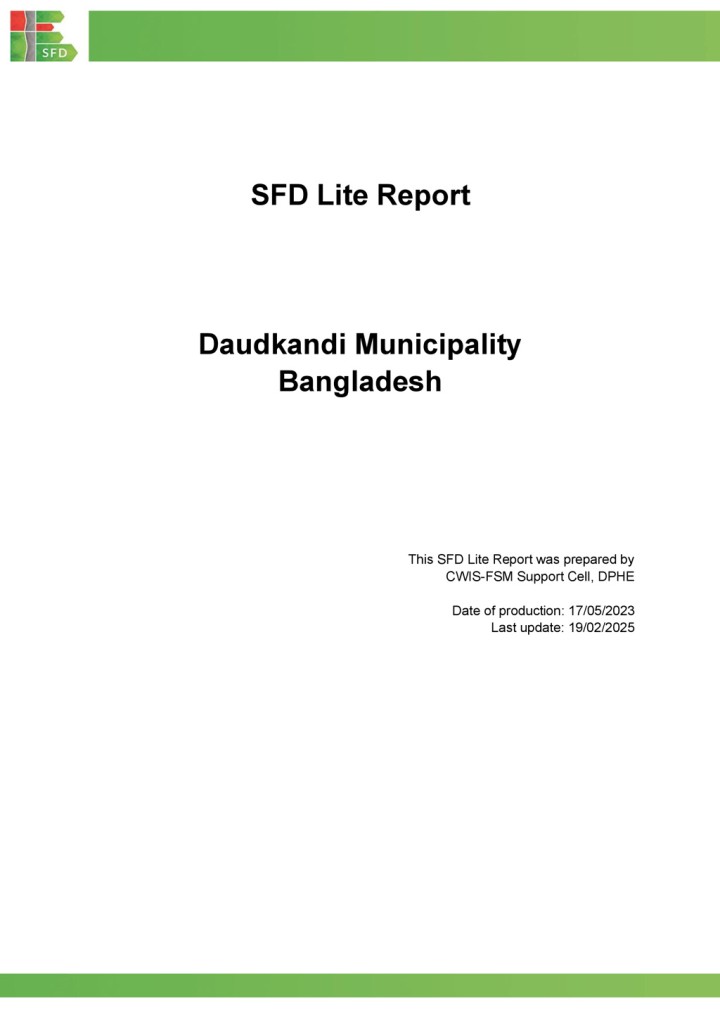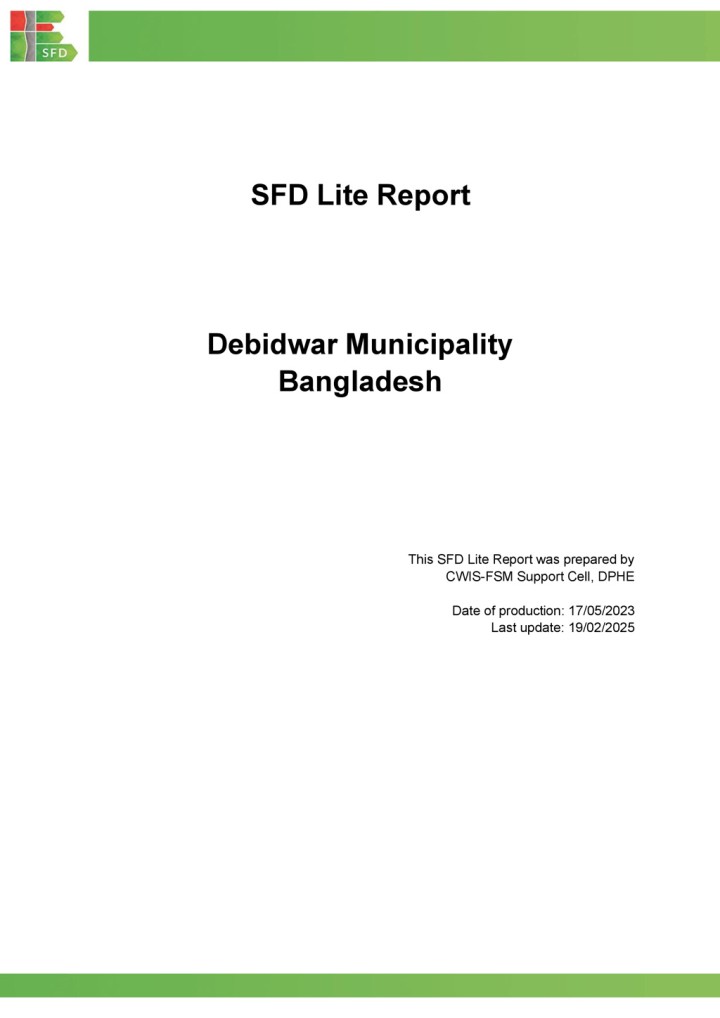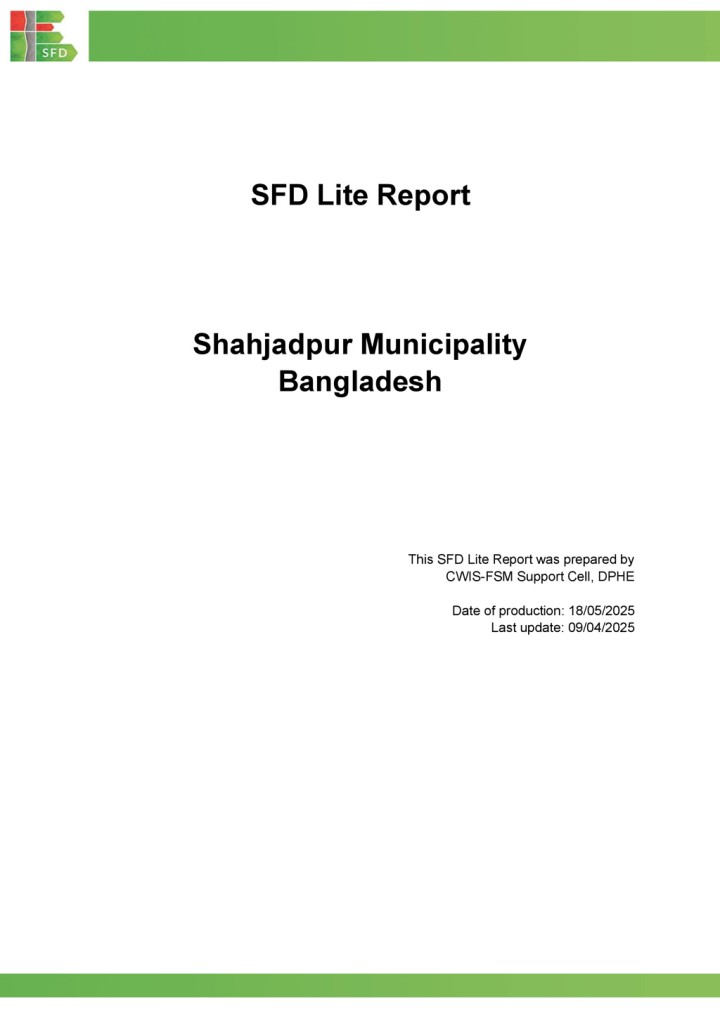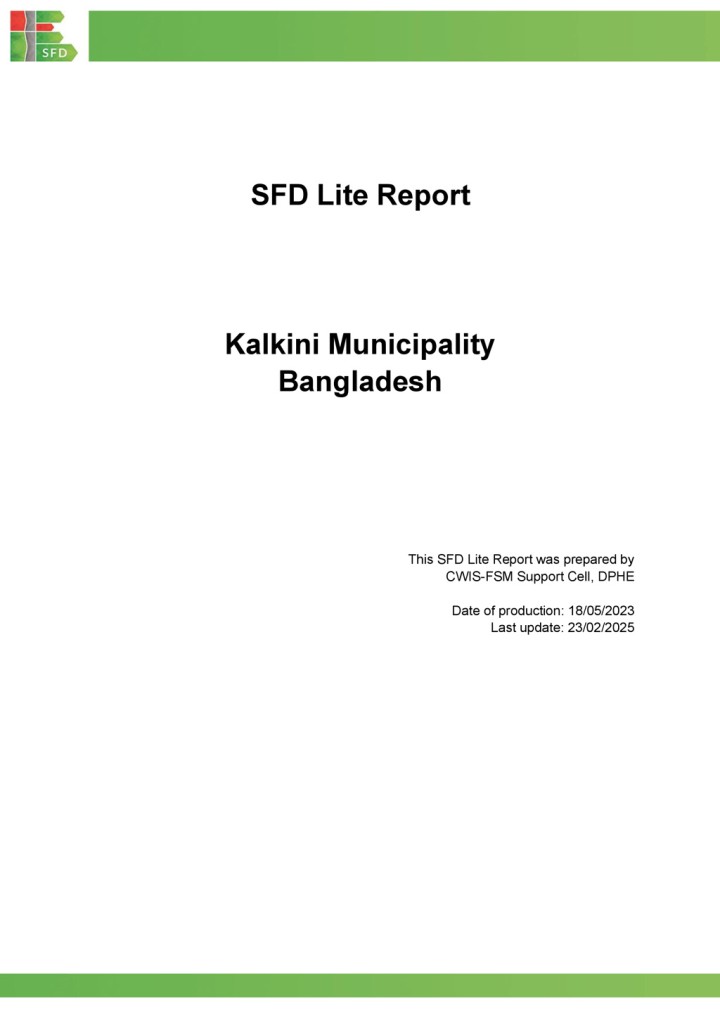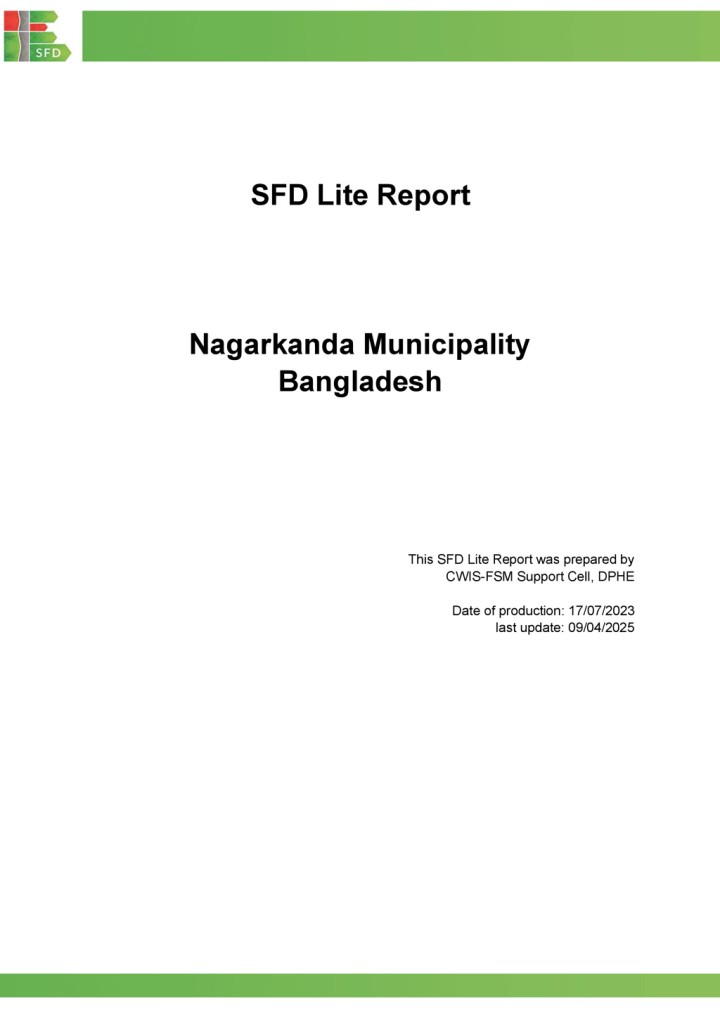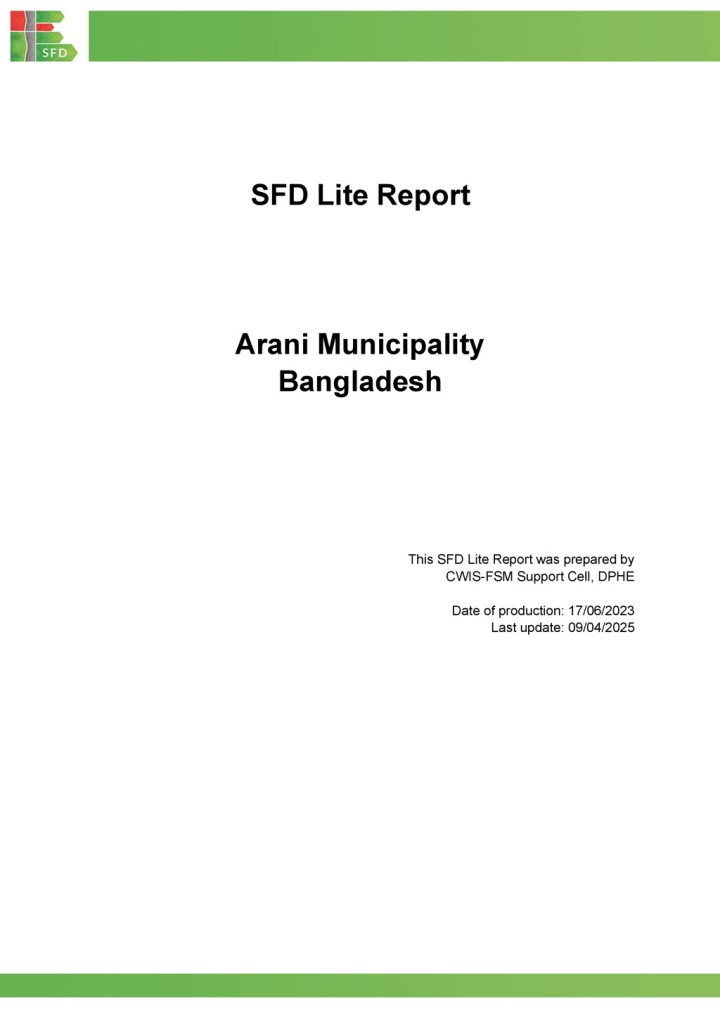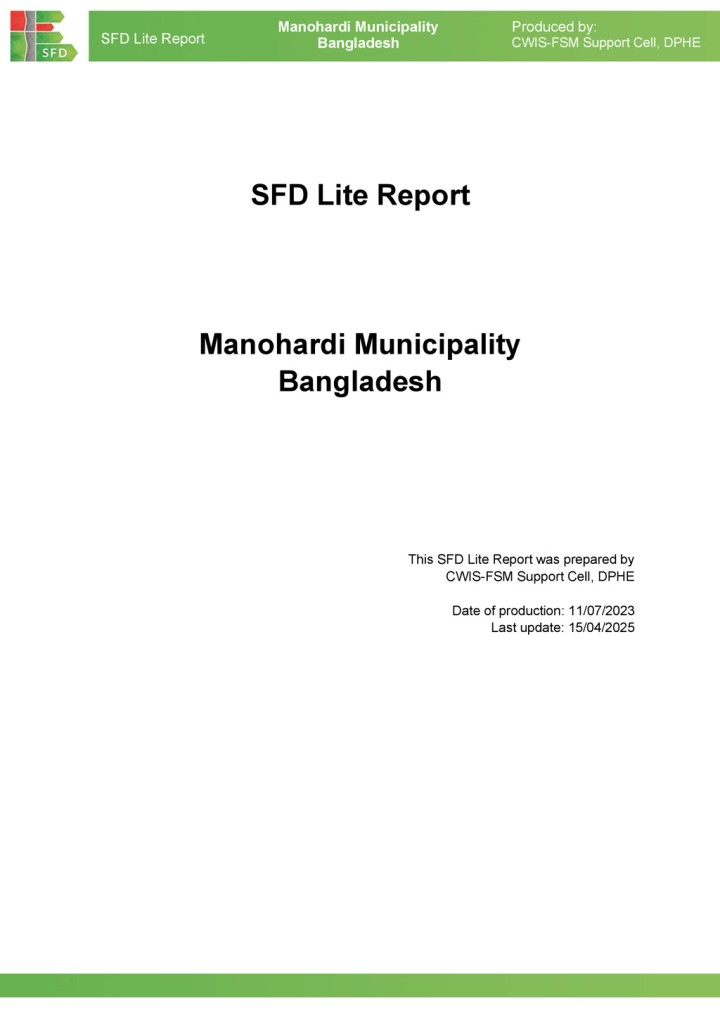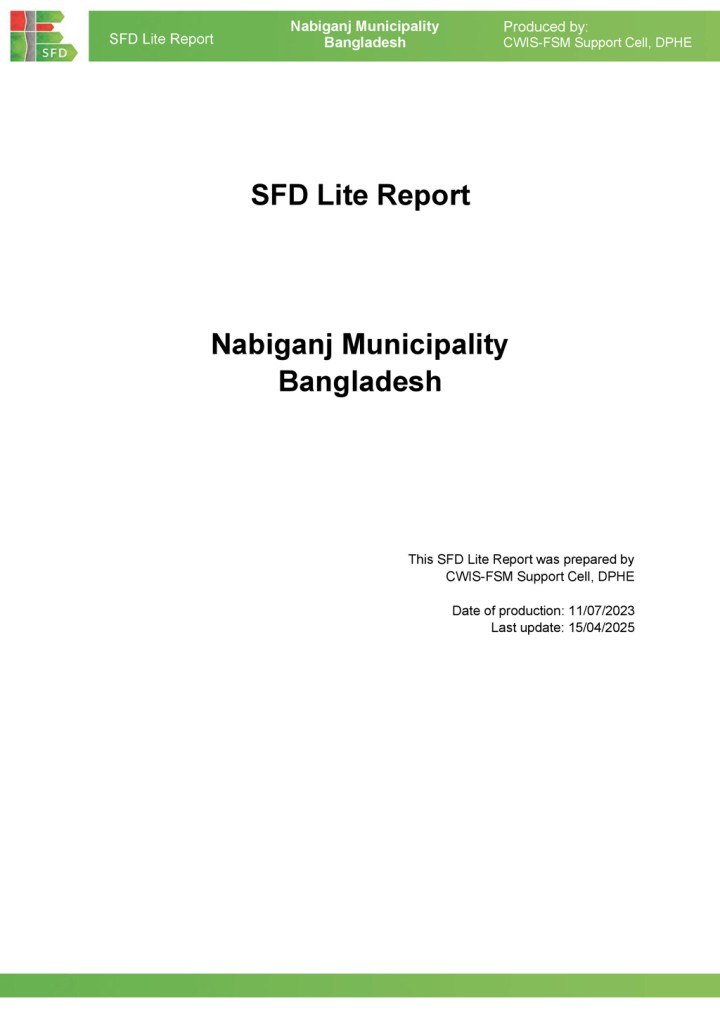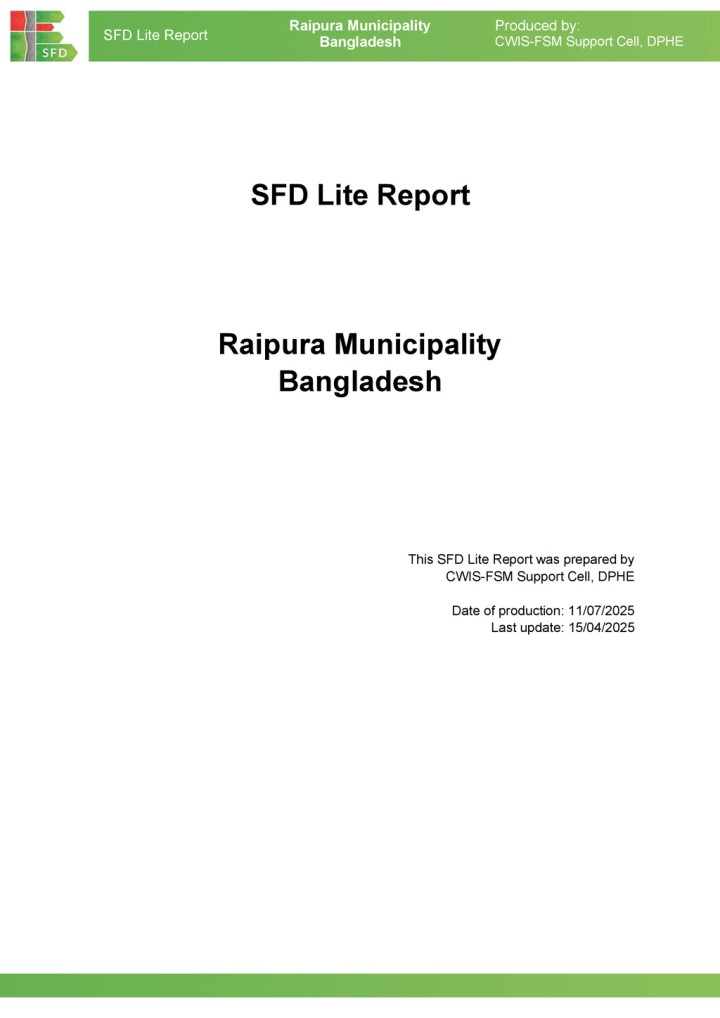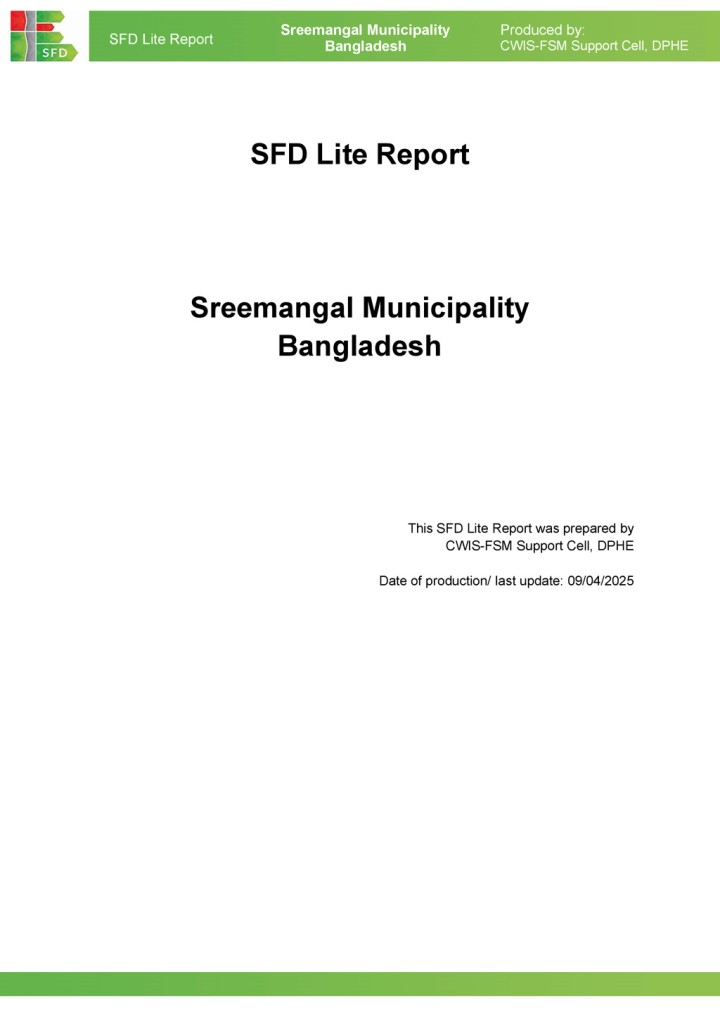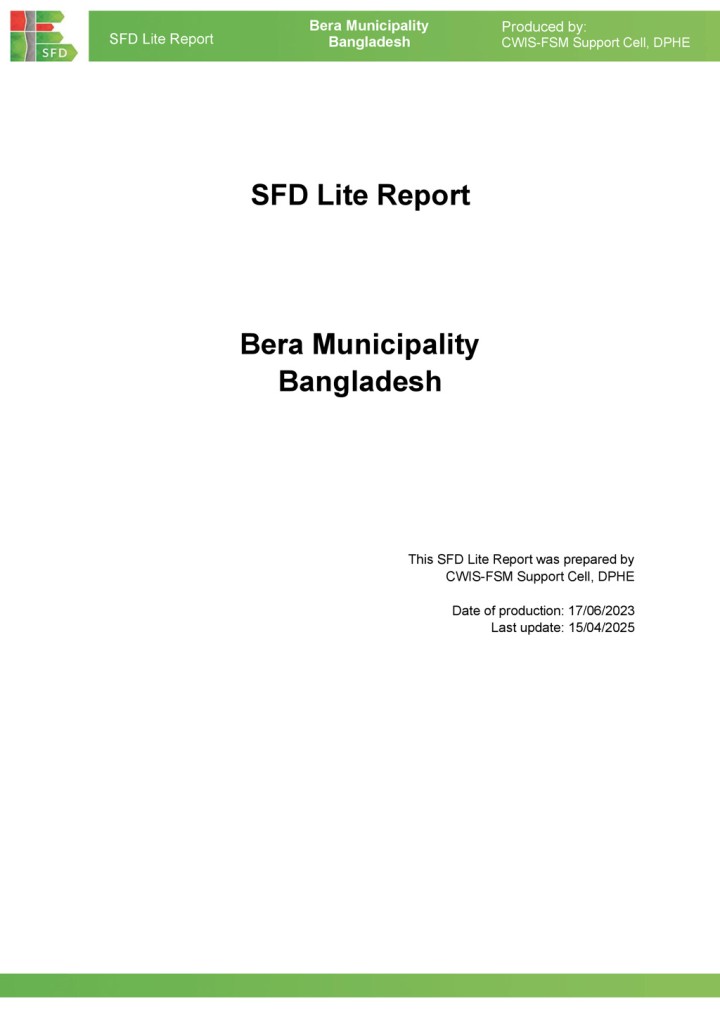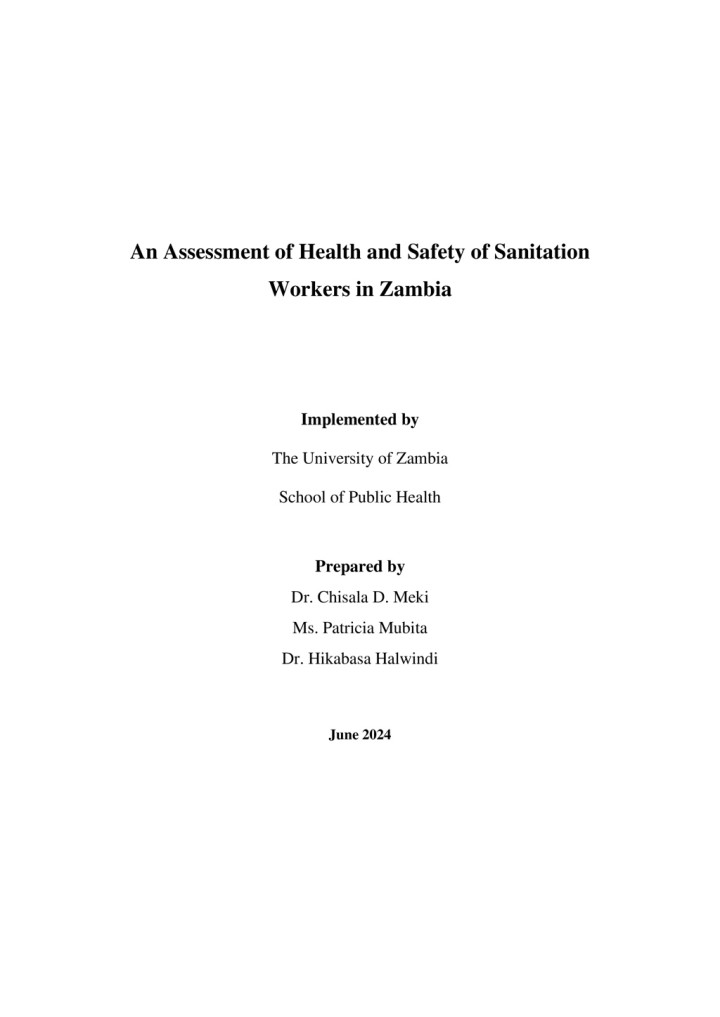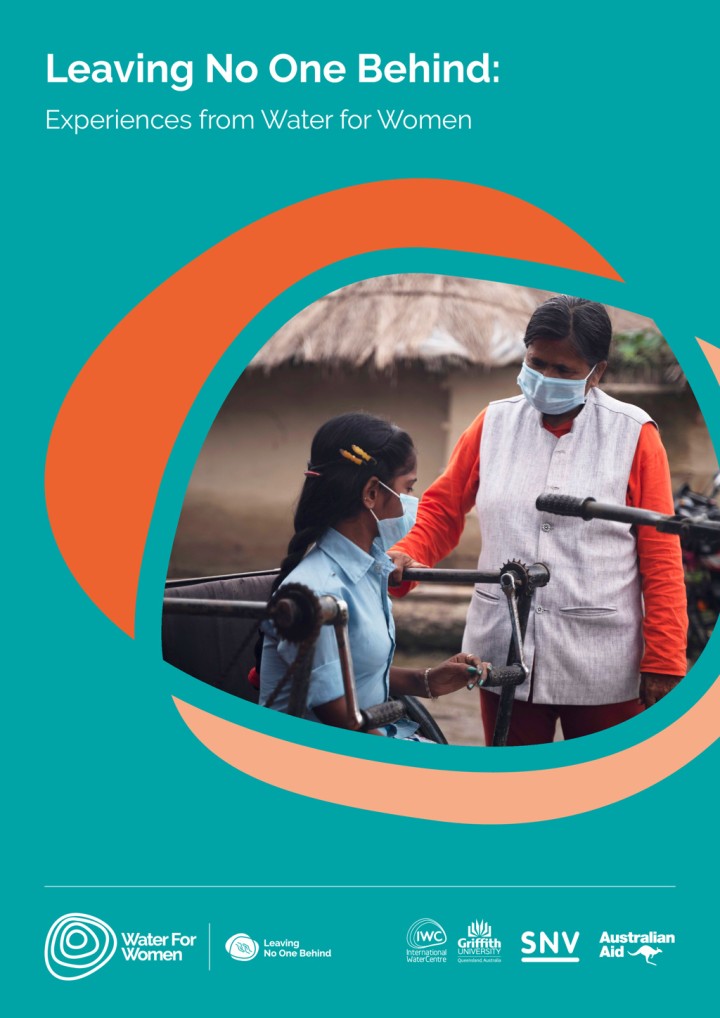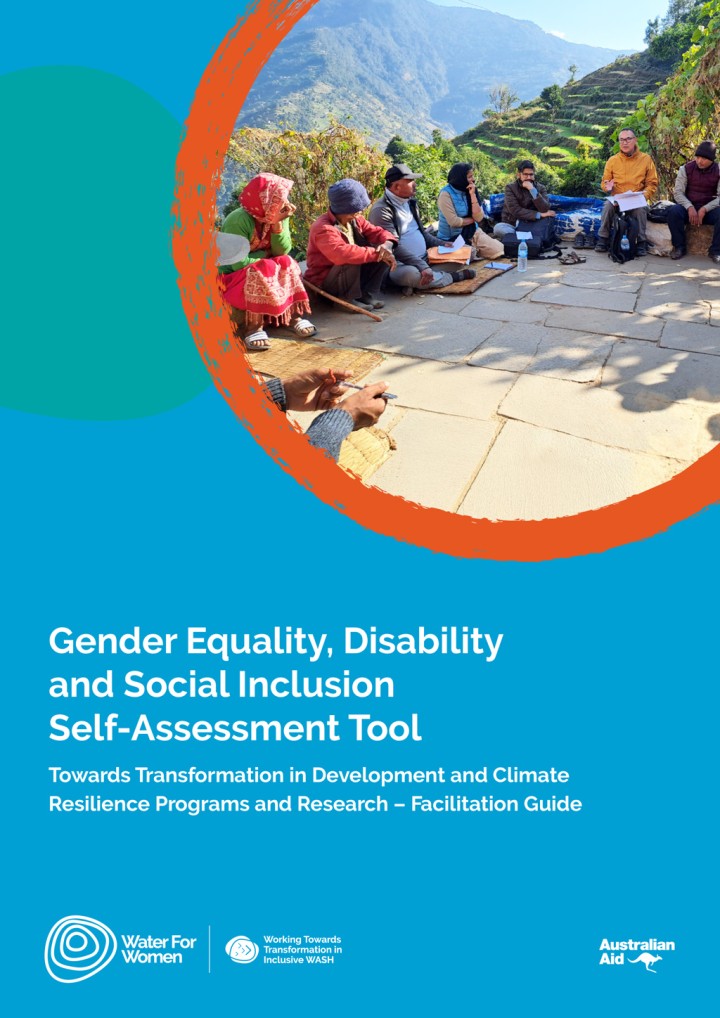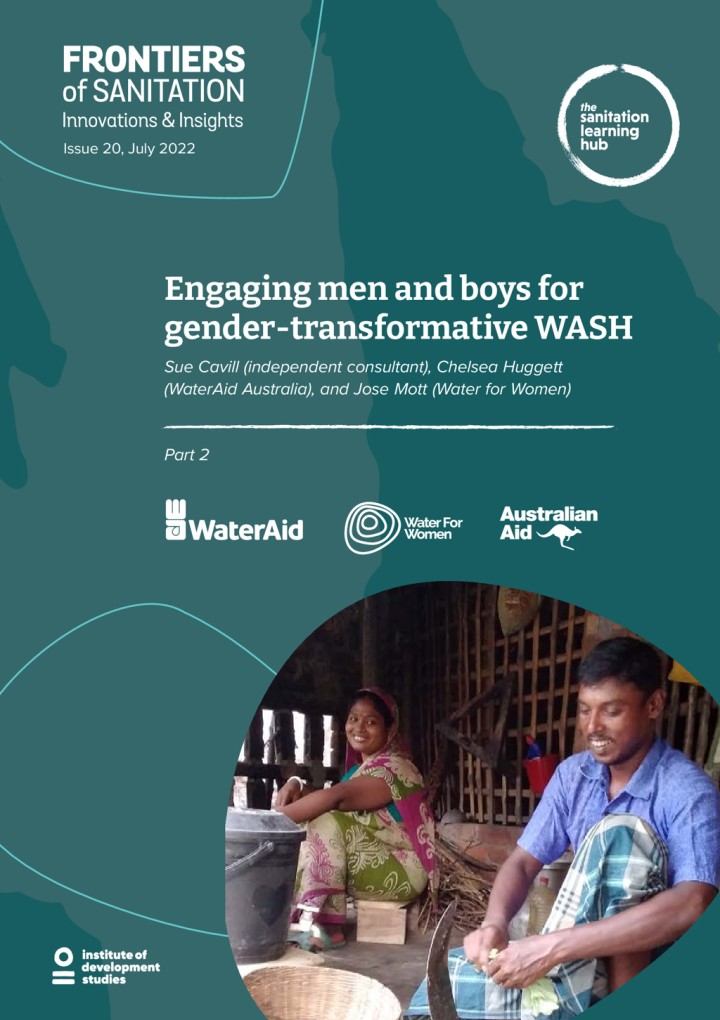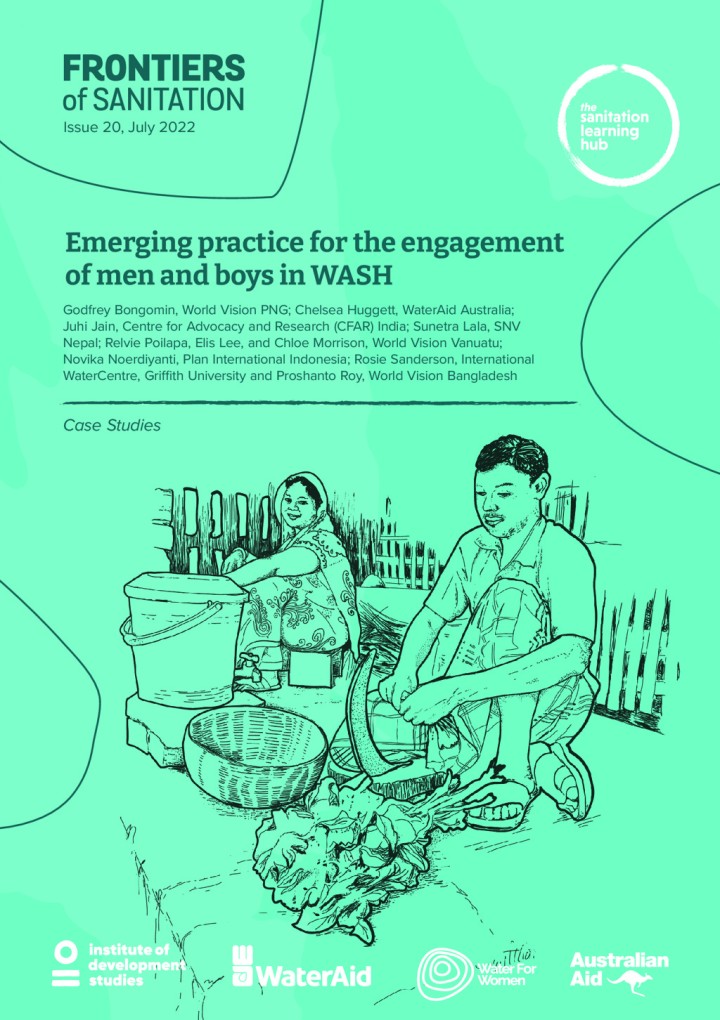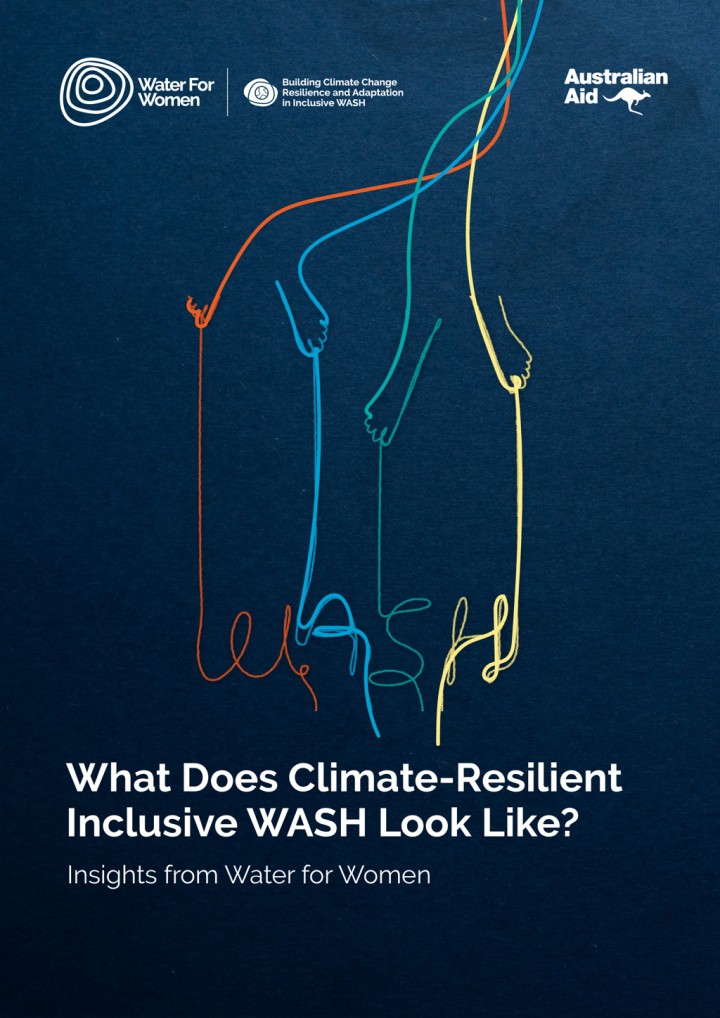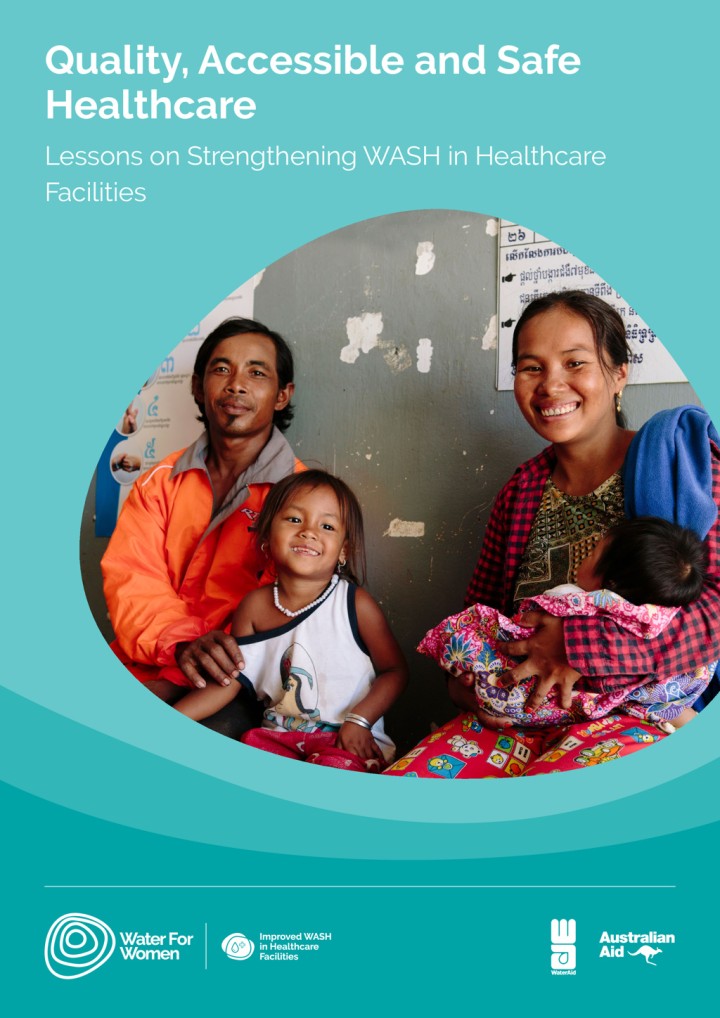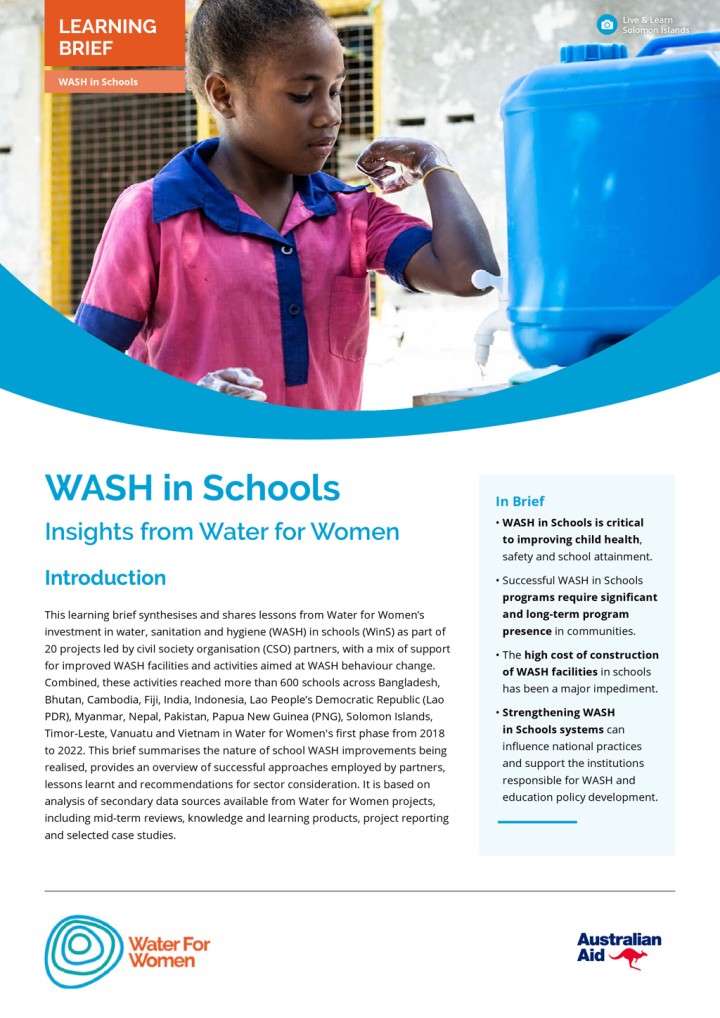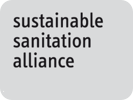One Drop Foundation (2021) WASH Systems Academy: Social Art for Behaviour Change™ The Basics
This course will provide you with a better understanding of the Social Art for Behaviour Change™ approach created by the One Drop foundation. It is a key element of the One Drop’s A•B•C for Sustainability™ Model. Be part of a growing community of practice of people who are curious about ways to increase the sustainability of WASH services thanks to collective intelligence.
CWIS-FSM Support Cell, DPHE (2025) SFD (Lite) Report - Daudkandi Municipality
Daudkandi Municipality is a Municipality in the Daudkandi Upazila, which is situated in Cumilla District under Chattogram Division. The Municipality is located at a distance of 40 km to the east of Cumilla city. The geographical coordinates of Daudkandi are 23° 31' 59.88" N and 90° 43' 0.12" E. It is bordered by the Upazilas of Meghna and Titas to the north, Matlab Dakshin and Kachua to […]
CWIS-FSM Support Cell, DPHE (2025) SFD (Lite) Report - Debidwar Municipality
Debidwar Municipality is a Municipality in the Debidwar Upazila, which is situated in Noakhali District under Chattogram Division. The geographical coordinates of Debidwar are 23°36'0.00"N and 90°59'3012"E. Debidwar Municipality is situated in the Cumilla District. It is bounded on the north by Muradnagar Upazila, on the south by Chandina Upazila, on the east by Burichang and Brahmanpara Upazilas, and on the west by Muradnagar Upazila. According […]
CWIS-FSM Support Cell, DPHE (2025) SFD (Lite) Report - Shahjadpur Municipality
Shahjadpur is an Upazila or Sub-District of the Sirajganj District in Bangladesh's Rajshahi Division. The Upazila consists of Shahjadpur Municipality. The geographical coordinates of Shahjadpur are 24°10'0" N and 89°36'0" E. Shahjadpur Municipality is situated in the Shajadpur Sub-district. The sub-district is bounded on the North by Ullapara and Belkuchi Upazilas, South by Bera and Santhia Upazilas, East by Chauhali Upazila, West by […]
CWIS-FSM Support Cell, DPHE (2025) SFD (Lite) Report - Kalkini Municipality
Kalkini Municipality is situated within the Kalkini Sub-District (Upazila) in Madaripur District (Zilla), under Dhaka division (Figure 2). The geographical coordinates of Kalkini are 23°00' N and 90°22' E. Kalkini Paurashava is situated in the Madaripur District. Madaripur is bordered on the north by Madaripur Sadar and Shariatpur Sadar Upazilas, on the south by Gaurnadi upazilas, on the east by Gosairhat, Muladi, and Damudya Upazilas, […]
CWIS-FSM Support Cell, DPHE (2025) SFD (Lite) Report - Nagarkanda Municipality
Nagarkanda Municipality is a municipality in the Nagarkanda Upazila, which is situated in Faridpur District under Dhaka Division. The geographical coordinates of Nagarkanda are 23° 24' N and 89° 53' E . Nagarkanda Upazila is bordered on the north by the Upazilas of Faridpur Sadar and Char Bhadrasan, on the south by the Upazila of Muksudpur, on the east by the Upazilas of Bhanga and Sadarpur, […]
CWIS-FSM Support Cell, DPHE (2025) SFD (Lite) Report - Arani Municipality
Arani Municipality lies within Bagha Sub-District (Upazila) in the Rajshahi District (Zila) which is under the Rajshahi Division. The geographical coordinates of Arani are 24° 17' 0" N and 88° 52' 0" E. Arani Municipality is situated in the Bagha Sub-District. It is bordered on the north by the Charghat and Bagatipara upazilas, on the south by the Daulatpur (Kushtia) upazila, on the east […]
CWIS-FSM Support Cell, DPHE (2025) SFD (Lite) Report - Manohardi Municipality
Manohardi Municipality is located within the Manohardi Sub-District (Upazila) situated in the Narsingdi District (Zila) under Dhaka Division. The geographical coordinates of Manohardi are between 24°07'40.08"N and 90°42'0.00" E. It is bordered on the north by the Upazilas of Pakundia and Katiadi, the south by the Upazila of Shibpur, the east by the Upazilas of Belabo and Katiadi, and the west by the Upazila of Kapasia. According […]
CWIS-FSM Support Cell, DPHE (2023) SFD (Lite) Report - Nabiganj Municipality
Nabiganj Municipality is located within the Nabiganj Sub-District (Upazila) situated in the Habiganj District (Zila) under Sylhet Division. The geographical coordinates of Nabiganj are 24°34'0.12"N and 91°31'0.12" E. It is bordered on the north by the Upazilas of Derai and Jagannathpur, on the south by the Upazilas of Habiganj Sadar and Bahubal, on the east by the Upazilas of Sreemangal, Maulvibazar Sadar, and Balaganj, and […]
CWIS-FSM Support Cell, DPHE (2025) SFD (Lite) Report - Raipura Municipality
Raipura Municipality is located within the Raipura Sub-District (Upazila) situated in the Narsingdi District (Zila) under Dhaka Division. The geographical coordinates of Raipura are 23°58'0.12" N and 90°52'30" E. It is bordered on the north by Belabo and Bhairab Upazilas, on the south by Nanchharampur, Nabinagar, and Narsingdi Sadar Upazilas, on the east by Brahmanbaria Sadar Upazilas, and on the west by Shibpur and Narsingdi […]
CWIS-FSM Support Cell, DPHE (2025) SFD (Lite) Report - Sreemangal Municipality
Sreemangal Municipality lies within Sreemangal Sub-District (Upazila) within the Moulvibazar District (Zilla), under Sylhet Division. The geographical coordinates of Sreemangal are 24°18'29.88'' N and 91 43'59.88" E (Figure 3). The district is bordered on the north by the Maulvibazar Sadar Upazila, on the south by the Indian state of Tripura, on the east by the Kamalganj Upazila, and on the west by the Upazilas of […]
CWIS-FSM Support Cell, DPHE (2025) SFD (Lite) Report - Bera Municipality
Bera Municipality is located within the Bera Sub-District (Upazila) situated in the Pabna District (Zila) under Rajshahi Division. The geographical coordinates of Bera are 24'35.65"N and 89°37'0.93" E. Chauhali, Daulatpur, and Shivalaya Upazilas on the east, Sujanagar, and Santhia Upazilas on the west, and Shahjadpur and Chauhali Upazilas on the north and south, respectively. According to the population census in 2011 by the Bangladesh […]
Dr. Chisala D. Meki; Patricia Mubita; Dr. Hikabasa Halwindi (2024) An Assessment of Health and Safety of Sanitation Workers in Zambia
Sanitation is a cornerstone of healthy communities. Pit emptiers play a critical role in maintaining public health and safety by removing waste from pit latrines and septic tanks. Despite their essential work, these individuals often toil in obscurity and face significant challenges accessing adequate health and safety protections, particularly in developing countries. This study investigated the health and safety of sanitation workers in Zambia and found […]
Water for Women (2022) Leaving No One Behind: Experiences from Water for Women
Developed as part of a dedicated initiative under Water for Women’s Learning Agenda, this report is a synthesis of insights from 16 water, sanitation and hygiene (WASH) projects being delivered by partner civil society organisations (CSOs). The report draws lessons from and syntheses CSO self-assessments on the approaches they pursue to ensure no one is left behind, structured by: • Who CSOs identify as being […]
Water for Women (2025) Gender Equality and Social Inclusion Self-Assessment Tool (Revised Edition)
The Gender Equality, Disability and Social Inclusion Self-Assessment Tool (GEDSI SAT) is a facilitation guide for climate resilience and development program managers, GEDSI advisers, researchers and interested members of staff, designed to support individual and collective reflective practice on the extent and quality of gender equality, disability and social inclusion work in programs and organisations. Drawing on a wealth of experience from across Water for […]
Sue Cavill; Chelsea Huggett and Jose Mott (2022) Engaging men and boys for gender-transformative WASH
Issue 20 of Frontiers of Sanitation and these accompanying case studies explore the extent to which engaging men and boys in WASH processes is leading to transformative change in gender roles, attitudes, and sustainable change in reducing gender inequalities across households, communities, organisations, and policy.
Bongomin, G.; Huggett, C.; Jain, J.; Lala, S.; Lee, E.; Morrison, C.; Noerdiyanti, N.; Poilapa, R.; Sanderson, R.; and Roy, P. (2022) Emerging practice for the engagement of men and boys in WASH
Issue 20 of Frontiers of Sanitation and these accompanying case studies explore the extent to which engaging men and boys in WASH processes is leading to transformative change in gender roles, attitudes, and sustainable change in reducing gender inequalities across households, communities, organisations, and policy.
Water for Women (2024) What Does Climate-Resilient Inclusive WASH Look Like? Insights from Water for Women
Under our collaborative Learning Agenda 2023-24, drawing on learnings from the implementation of climate-resilient and inclusive WASH projects and research across Asia–Pacific, partners sought to explore this fundamental learning question through a series of dedicated initiatives.
Water for Women (2023) Quality, Accessible and Safe Healthcare: Lessons on Strengthening WASH in Healthcare Facilities
This report highlights the achievements of Water for Women civil society organisation (CSO) partners in improving WASH in healthcare facilities (HCFs) in eight Asia-Pacific countries, including Bhutan, Cambodia, India, Myanmar, Pakistan, Papua New Guinea, Solomon Islands and Vanuatu. It draws out lessons learnt from partners' practical experience and research across the Fund. The recommendations should inform CSOs’ future project designs and advocacy to important […]
Water for Women (2023) WASH in Schools Insights from Water for Women
This learning brief synthesises and shares lessons from Water for Women’s investment in water, sanitation and hygiene in schools as part of 20 projects led by civil society organisation partners, with a mix of support for improved WASH facilities and activities aimed at WASH behaviour change. Combined, these activities reached more than 600 schools across Bangladesh, Bhutan, Cambodia, Fiji, India, Indonesia, Lao People’s Democratic Republic (Lao […]
